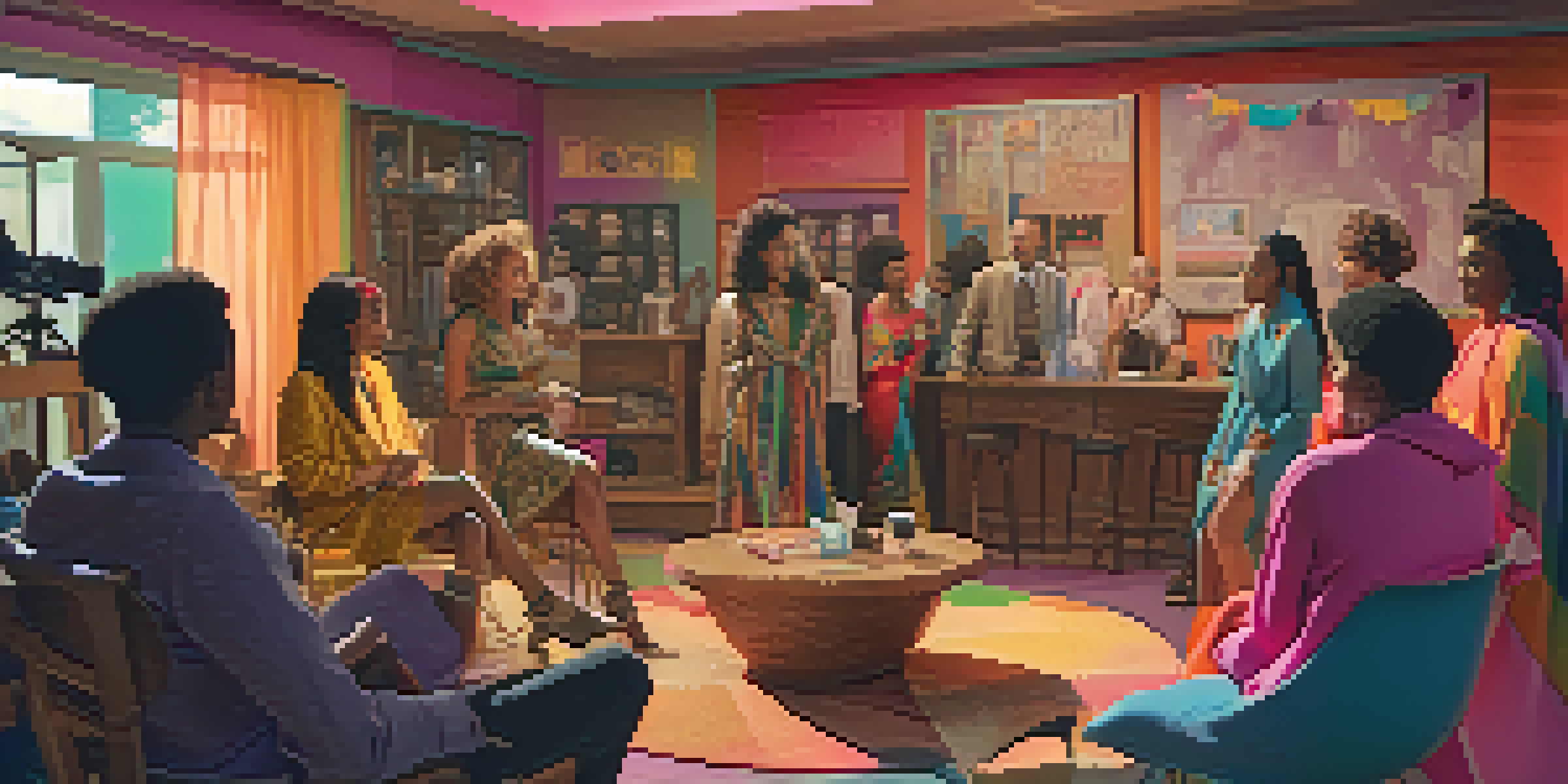Trans Representation in Hollywood: Progress and Challenges

Understanding Trans Representation in Film and TV
Trans representation in Hollywood refers to the portrayal of transgender characters and stories in films and television. This representation matters because it shapes public perception and understanding of trans identities. Historically, trans characters were often misrepresented or completely absent, leading to a lack of visibility.
Representation matters. It shapes how we see ourselves and how we see each other.
However, as society evolves and conversations around gender identity become more prominent, the demand for authentic representation grows. More filmmakers and producers are recognizing the importance of telling trans stories and involving trans individuals in the creative process. This shift is crucial for fostering empathy and breaking down stereotypes.
The journey toward better representation isn't just about visibility—it's also about authenticity. Audiences increasingly want to see real trans voices and experiences reflected in the media, rather than relying on outdated tropes. This desire for authenticity is driving change within Hollywood, sparking discussions about who gets to tell which stories.
Milestones in Trans Representation
There have been significant milestones in trans representation over the years, marking a gradual shift in Hollywood's approach. One landmark moment was the release of 'Boys Don't Cry' in 1999, which brought attention to the struggles faced by trans individuals. Though the film had its criticisms, it opened the door for more nuanced stories.

In recent years, series like 'Pose' have taken the spotlight, showcasing the lives of trans people in the ballroom culture of the 1980s and 90s. Notably, the show features a predominantly trans cast, allowing these actors to share their authentic experiences with the world. This kind of representation not only entertains but educates audiences about the complexity of trans lives.
Importance of Authentic Representation
Authentic representation in film and TV fosters empathy and breaks down stereotypes surrounding trans identities.
Moreover, the success of these projects demonstrates that there is a market for diverse stories. Hollywood is beginning to recognize that authentic representation can lead to greater audience engagement and support. As more milestones are reached, the hope is that these narratives will continue to expand and evolve.
The Role of Trans Creators in Hollywood
Trans creators play a vital role in shaping the narratives around trans characters and experiences. By being involved behind the scenes as writers, directors, and producers, they can ensure that stories are told with authenticity and respect. Their perspectives are invaluable in breaking down stereotypes and challenging misconceptions.
The stories we tell reflect the world we live in, and they can change the world we live in.
For instance, trans creators like Janet Mock and Laverne Cox have not only acted in but also produced and directed content that highlights trans issues. Their involvement brings a level of authenticity that is often missing in productions led by non-trans individuals. This shift is essential in creating a more inclusive Hollywood.
Additionally, the presence of trans creators encourages younger generations to pursue careers in the industry. By seeing people like themselves represented, aspiring trans artists may feel empowered to share their stories. This cycle of representation and creation is crucial for the ongoing progress in Hollywood.
Challenges Still Faced by Trans Actors
Despite the progress made, trans actors still encounter numerous challenges in Hollywood. Many face typecasting, where they are only offered roles that fit narrow definitions of what it means to be trans. This limits their opportunities and can perpetuate harmful stereotypes.
Moreover, trans actors often struggle for equal pay and recognition compared to their cisgender counterparts. This disparity highlights the ongoing need for advocacy and support within the industry. Organizations and allies must work together to ensure fair treatment and opportunities for trans performers.
Role of Trans Creators
Trans creators are essential for ensuring that trans stories are told with authenticity and respect, challenging misconceptions in Hollywood.
The lack of roles that portray the full spectrum of trans experiences also remains a significant hurdle. While some progress has been made, many stories still go untold. Addressing these challenges is crucial for fostering a more inclusive environment where all trans stories can be shared and celebrated.
Audience Reception and Impact of Trans Stories
The reception of trans stories in Hollywood has evolved, with audiences increasingly embracing diverse narratives. Viewers are often drawn to authentic portrayals that resonate with their own experiences or challenge their perceptions. This shift has created a demand for more inclusive content across various platforms.
Positive audience reception can lead to greater investment in trans stories, encouraging studios to produce more content that reflects real-life experiences. When audiences support these projects, it sends a clear message to Hollywood that there is a market for authentic representation. This can inspire more creators to take risks and tell underrepresented stories.
Furthermore, the impact of trans stories extends beyond the screen. They can foster conversations about gender identity and inclusion, helping to educate audiences and promote understanding. This ripple effect is essential for creating a more accepting society.
The Importance of Intersectionality in Representation
Intersectionality plays a crucial role in understanding trans representation in Hollywood. It involves recognizing how various aspects of identity—such as race, class, and sexuality—intersect to shape individual experiences. This lens is essential for telling rich, nuanced stories that reflect the diversity within the trans community.
For example, trans people of color often face unique challenges that differ from those of white trans individuals. Highlighting these differences in media can foster a deeper understanding of the systemic barriers faced by marginalized groups. As Hollywood continues to evolve, embracing intersectionality will be vital for authentic representation.
Challenges for Trans Actors
Despite progress, trans actors still face typecasting and unequal pay, highlighting the need for ongoing advocacy and support within the industry.
By prioritizing intersectionality, creators can craft narratives that resonate with a broader audience. This approach not only enriches storytelling but also ensures that all voices within the trans community are heard and valued. A commitment to intersectional representation is essential for meaningful progress in Hollywood.
Looking Ahead: The Future of Trans Representation
As Hollywood continues to evolve, the future of trans representation looks promising yet requires ongoing effort. The push for authentic stories and diverse voices is gaining momentum, driven by both creators and audiences alike. This collective advocacy is crucial for fostering a culture that values inclusion and representation.
Emerging platforms, such as streaming services, are also playing a significant role in amplifying trans narratives. With more space for diverse content, there's an opportunity to explore a wide range of stories that reflect the complexities of trans lives. This new landscape offers the potential for groundbreaking projects that can challenge stereotypes and broaden understanding.

Ultimately, the future hinges on collaboration between trans creators, allies, and audiences. By continuing to support and uplift trans voices, Hollywood can pave the way for a more inclusive industry. The journey toward equitable representation is ongoing, but with commitment and passion, meaningful change is within reach.